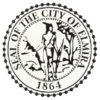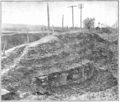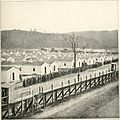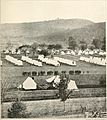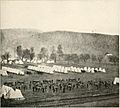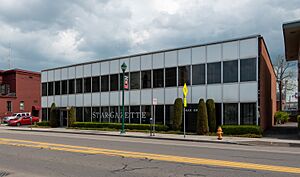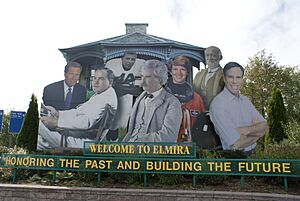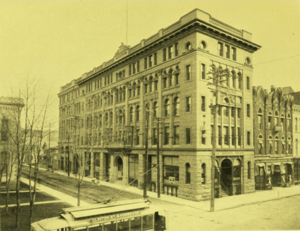Elmira, New York facts for kids
Quick facts for kids
Elmira
|
|||
|---|---|---|---|
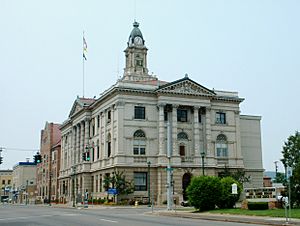 |
|||
|
|||
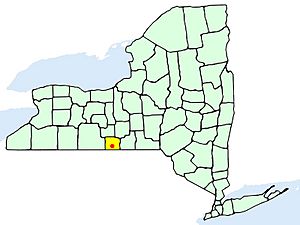
Location in Chemung County in the state of New York
|
|||
| Country | United States | ||
| State | New York | ||
| County | Chemung | ||
| Incorporated | 1864 | ||
| Area | |||
| • City | 7.58 sq mi (19.63 km2) | ||
| • Land | 7.25 sq mi (18.78 km2) | ||
| • Water | 0.33 sq mi (0.85 km2) | ||
| Elevation | 860 ft (260 m) | ||
| Population
(2020)
|
|||
| • City | 26,523 | ||
| • Density | 3,657.34/sq mi (1,412.09/km2) | ||
| • Metro | 90,070 (Chemung County) | ||
| Time zone | UTC−5 (EST) | ||
| • Summer (DST) | UTC−4 (EDT) | ||
| ZIP Codes |
14901, 14904, 14905
|
||
| Area code(s) | 607 | ||
| FIPS code | 36-015-24229 | ||
| Website | www.CityOfElmira.net | ||
Elmira is a city in Chemung County, New York. It is the main city of the Elmira area. In 2020, about 26,523 people lived there.
The City of Elmira is in the south-central part of Chemung County. It is surrounded by the Town of Elmira on three sides. The city is in the Southern Tier of New York, close to the Pennsylvania border.
During the American Civil War, Elmira was home to the Elmira Prison. This was a camp for over 12,000 captured Confederate soldiers. Elmira College is also located in the city.
Contents
Elmira's Past: A Look at History
Early Days of Elmira
Before Europeans arrived, the Elmira area was home to the Cayuga nation. They were part of the Haudenosaunee people. The Cayuga traded furs with European settlers. But they mostly lived peacefully on their own.
During the American Revolutionary War, the Continental Army fought against the British and their Haudenosaunee allies. A big battle, the Battle of Newtown, happened south of where Elmira is today. The Continental Army won this battle. After the war, a peace treaty was signed in Elmira in 1791. Most of the Cayuga people later moved to Canada.
The first European-American settler in Elmira was Abraham Miller. He built a cabin after the Revolutionary War. Miller's Pond and Miller Street are named after him.
How Elmira Was Formed
In 1788, the New York government created the Township of Chemung. The settlement of Newtown was then started. It was located where Newtown Creek meets the Chemung River. In 1792, Newtown joined with other settlements to form the village of Newtown.
In 1808, the village changed its name to the Town of Elmira. Some say it was named after a tavern owner's daughter, Elmira Teal. Another story says it was named after Matthew Carpenter's daughter in 1821.
The City of Elmira, also called "The Queen City," officially became a city in 1864. It was formed from parts of the town and village of Elmira. The town of Elmira still exists today, surrounding the city.
Elmira became a major transportation center in the 1800s. It connected cities like Rochester and Buffalo with Albany and New York City. This was possible thanks to canals and railroads.
- The Chemung Canal opened in 1833, connecting Elmira to other areas.
- The Junction Canal later linked Elmira with Corning. This helped transport coal from Pennsylvania.
- In 1849, the New York and Erie Railroad came through Elmira. This created a route from New York City to Buffalo.
- Other railroads also connected Elmira to the north and south.
These railway connections made Elmira an important place for the Army. It was used as a training and gathering point during the American Civil War.
The Civil War Prison Camp
During the Civil War, a large Union Army camp called Camp Rathbun was in Elmira. Part of this camp, known as "Barracks #3," became a prisoner of war camp in 1864. Prisoners called it "Hellmira" because of the harsh conditions.
From June 1864 to autumn 1865, 12,123 Confederate soldiers were held there. Sadly, 2,963 of them died. This was due to poor food, cold winters, and bad sanitation. An ex-slave named John W. Jones prepared the dead for burial. They were buried at Woodlawn National Cemetery.
After the war, prisoners were released and given train tickets home. The camp closed in September 1865. Today, the prison camp site is a residential area. Woodlawn Cemetery, where the soldiers are buried, became a "National Cemetery" in 1877.
Elmira Reformatory
In 1866, the state decided to build a prison for first-time offenders. It opened in 1876 as the Elmira Reformatory. Zebulon Brockway was its director. This was the first place of its kind and became a model for others. In 1970, it was renamed the Elmira Correctional and Reception Center.
Elmira's Changing Economy
In 1950, Elmira's population was about 50,000 people. This was more than half of Chemung County's population. Today, the city has about 25,000 residents. This decline happened because railroads and manufacturing became less important across the country. Also, more people moved to the suburbs around Elmira.
Many large factories closed or moved away in the early 1970s. Then, in 1972, a big flood caused a lot of damage. Many businesses and homes were destroyed. The city tried to rebuild with the "New Elmira Plan." This plan removed many buildings downtown to create a park and parking garages. Some people felt the plan changed the city's unique feel.
Local Businesses and Manufacturing
Elmira still has important manufacturing companies:
- Anchor Glass Container Corporation makes glass containers for drinks and food.
- CAF-USA Inc builds trains and rail equipment for North America.
- Elmira Heat Treating uses heat to treat metals for various customers.
- Hardinge, Inc. makes precise turning machines for factories. They also own famous brands like Bridgeport.
- Hilliard Corporation makes filters, brakes, clutches, and starters for industrial and consumer products.
- Kennedy Valve is known for making fire hydrants and other water system products. You can find their fire hydrants all over the world!
- Trayer Products makes parts for heavy trucks, like king pins.
Major Weather Events
The 1972 Flood from Hurricane Agnes
In the summer of 1972, Hurricane Agnes caused huge floods across the eastern U.S. Elmira was hit very hard. The damage was estimated at over $291 million. More than 15,000 people had to leave the city. About 5,000 homes were damaged or destroyed. Local churches and businesses helped with the cleanup.
The 1993 "Storm of the Century"
In March 1993, Elmira experienced a huge snow blizzard. It was called the "Storm of the Century." The city received 17 inches of snow in just one day!
2012 Tornado
On July 26, 2012, an EF1 tornado touched down in Elmira. It caused moderate damage, blowing down hundreds of trees and power lines. Luckily, no one was hurt. This was surprising because tornadoes are not common in this area.
Elmira's Location and Weather
Elmira is located at 42°5′23″N 76°48′34″W / 42.08972°N 76.80944°W.
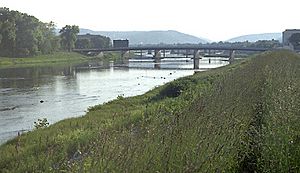
The city covers about 7.58 square miles (19.6 square kilometers). Most of this is land, with a small amount of water. The Chemung River flows through the city. Elmira is built mostly on the river's flood plain. This is why it has had many floods, like the one in 1972. Newtown Creek also joins the Chemung River in Elmira.
Major roads connect Elmira to other places:
- Interstate 86/New York State Route 17, also called The Southern Tier Expressway, has an exit in Elmira.
- New York State Route 14 goes through Elmira, connecting it to Watkins Glen and Pennsylvania.
- New York State Route 13 ends in Elmira after traveling from Lake Ontario.
- New York State Route 352 starts in Elmira and goes west to Corning.
| Climate data for Elmira, New York (1991–2020 normals, extremes 1894–present) | |||||||||||||
|---|---|---|---|---|---|---|---|---|---|---|---|---|---|
| Month | Jan | Feb | Mar | Apr | May | Jun | Jul | Aug | Sep | Oct | Nov | Dec | Year |
| Record high °F (°C) | 72 (22) |
70 (21) |
86 (30) |
93 (34) |
96 (36) |
102 (39) |
104 (40) |
102 (39) |
107 (42) |
93 (34) |
87 (31) |
69 (21) |
107 (42) |
| Mean maximum °F (°C) | 56 (13) |
56 (13) |
67 (19) |
81 (27) |
88 (31) |
92 (33) |
93 (34) |
92 (33) |
89 (32) |
79 (26) |
68 (20) |
57 (14) |
95 (35) |
| Mean daily maximum °F (°C) | 33.7 (0.9) |
36.3 (2.4) |
44.8 (7.1) |
58.5 (14.7) |
71.1 (21.7) |
79.2 (26.2) |
83.7 (28.7) |
82.1 (27.8) |
74.9 (23.8) |
61.7 (16.5) |
48.8 (9.3) |
38.5 (3.6) |
59.4 (15.2) |
| Daily mean °F (°C) | 24.8 (−4.0) |
26.4 (−3.1) |
34.0 (1.1) |
45.9 (7.7) |
57.7 (14.3) |
66.5 (19.2) |
71.0 (21.7) |
69.5 (20.8) |
62.2 (16.8) |
50.3 (10.2) |
39.3 (4.1) |
30.5 (−0.8) |
48.2 (9.0) |
| Mean daily minimum °F (°C) | 15.9 (−8.9) |
16.5 (−8.6) |
23.1 (−4.9) |
33.4 (0.8) |
44.4 (6.9) |
53.9 (12.2) |
58.3 (14.6) |
56.9 (13.8) |
49.5 (9.7) |
38.8 (3.8) |
29.9 (−1.2) |
22.5 (−5.3) |
36.9 (2.7) |
| Mean minimum °F (°C) | −3 (−19) |
−1 (−18) |
6 (−14) |
21 (−6) |
31 (−1) |
41 (5) |
47 (8) |
46 (8) |
36 (2) |
27 (−3) |
16 (−9) |
6 (−14) |
−6 (−21) |
| Record low °F (°C) | −24 (−31) |
−21 (−29) |
−10 (−23) |
6 (−14) |
21 (−6) |
32 (0) |
40 (4) |
31 (−1) |
23 (−5) |
15 (−9) |
3 (−16) |
−16 (−27) |
−24 (−31) |
| Average precipitation inches (mm) | 2.12 (54) |
1.86 (47) |
2.73 (69) |
3.26 (83) |
3.10 (79) |
4.19 (106) |
4.05 (103) |
3.82 (97) |
4.09 (104) |
3.53 (90) |
2.73 (69) |
2.59 (66) |
38.07 (967) |
| Average snowfall inches (cm) | 8.4 (21) |
9.5 (24) |
11.2 (28) |
1.5 (3.8) |
0.0 (0.0) |
0.0 (0.0) |
0.0 (0.0) |
0.0 (0.0) |
0.0 (0.0) |
0.1 (0.25) |
2.7 (6.9) |
8.4 (21) |
41.8 (106) |
| Average extreme snow depth inches (cm) | 7 (18) |
7 (18) |
7 (18) |
1 (2.5) |
0 (0) |
0 (0) |
0 (0) |
0 (0) |
0 (0) |
0 (0) |
2 (5.1) |
5 (13) |
11 (28) |
| Average precipitation days (≥ 0.01 in) | 12.2 | 9.8 | 10.6 | 12.5 | 13.2 | 12.6 | 11.8 | 11.4 | 10.6 | 13.0 | 10.6 | 11.8 | 140.1 |
| Average snowy days (≥ 0.1 in) | 6.4 | 5.6 | 3.7 | 0.9 | 0.0 | 0.0 | 0.0 | 0.0 | 0.0 | 0.1 | 1.4 | 3.6 | 21.7 |
| Source: NOAA | |||||||||||||
People of Elmira: Demographics
| Historical population | |||
|---|---|---|---|
| Census | Pop. | %± | |
| 1870 | 15,863 | — | |
| 1880 | 20,541 | 29.5% | |
| 1890 | 30,893 | 50.4% | |
| 1900 | 35,672 | 15.5% | |
| 1910 | 37,176 | 4.2% | |
| 1920 | 45,993 | 23.7% | |
| 1930 | 47,397 | 3.1% | |
| 1940 | 45,106 | −4.8% | |
| 1950 | 49,716 | 10.2% | |
| 1960 | 46,517 | −6.4% | |
| 1970 | 39,945 | −14.1% | |
| 1980 | 35,327 | −11.6% | |
| 1990 | 33,724 | −4.5% | |
| 2000 | 30,940 | −8.3% | |
| 2010 | 29,200 | −5.6% | |
| 2020 | 26,523 | −9.2% | |
| U.S. Decennial Census | |||
In 2000, Elmira had 30,940 people living there. About 82% were White, and 13% were Black or African American. About 3% of the population was Hispanic or Latino.
The average age in the city was 33 years old. About 25% of the people were under 18. The average household had 2.37 people. The three largest ethnic groups in Elmira are Irish, German, and Italian.
Media and News in Elmira
Local Newspapers
- Star-Gazette: This is Elmira's daily morning newspaper.
- Chemung Valley Reporter: A weekly newspaper from nearby Horseheads.
Radio Stations
You can listen to many radio stations in Elmira, including:
- WCIH
- WNKI
- WCBF
- WELM
- WLVY
- WPIE
- WOKN
- WKPQ / WHHO
- WLEA / WCKR
- WCID
- WENI-FM
- WPGO
Television Channels
Elmira also has several TV stations:
- WETM 18 (NBC)
- WETM-DT2 18.2 (ANT)
- WSKA 30 (PBS)
- WENY-TV 36 (ABC on DT1/CBS on DT2/CW on DT3)
- WJKP-LD 39 (MyNetworkTV)
- WYDC 48 (FOX)
Getting Around: Transportation
Public Transit
The Chemung County Transit System offers bus services within Elmira and Horseheads. There's also a route connecting Elmira to Corning Community College.
Elmira is also served by intercity bus companies like New York Trailways and Short Line. OurBus provides service from Elmira to New York City and Niagara Falls.
Air Travel
The Elmira Corning Regional Airport (ELM) is about 7 miles northwest of downtown. It offers scheduled flights to cities like Detroit and seasonal flights to Atlanta and Florida.
Elmira's Culture and Fun Places
Elmira's city slogan is "Honoring the Past, Building the Future". This slogan is on a welcome sign at the city's entrance. The sign also honors famous people from Elmira, like Ernie Davis, Mark Twain, and Tommy Hilfiger.
Elmira is famous for the sport of gliding. On Harris Hill, pioneer pilots started gliding in America. Harris Hill is now home to the National Soaring Museum. It was also used for glider training during World War 2. These sites are recognized as National Landmarks of Soaring.
The SS Elmira Victory, a ship from World War 2, was named after the city.
Here are some cool places in Elmira:
- Dunn Field: A baseball stadium where the Elmira Pioneers play. Famous baseball players like Babe Ruth and Wade Boggs have played here.
- Elmira College: A college located in the city.
- Lake Erie College of Osteopathic Medicine: A branch of this medical school is in Elmira.
- Clemens Center: A concert and theater center named after Samuel Clemens (Mark Twain).
- Arnot Art Museum: An art museum in the downtown area.
- Eldridge Park: Features a restored 1890s Looff Carousel.
- Woodlawn Cemetery and Woodlawn National Cemetery: These cemeteries are in Elmira. Mark Twain and his family are buried in Woodlawn Cemetery.
- LECOM Event Center: An arena that hosts the Elmira Aviators hockey team.
Education in Elmira
The Elmira City School District serves the students in Elmira.
Historic Places to Visit
Many places in Elmira are listed on the National Register of Historic Places. This means they are important historical sites. Some of these include:
- The John Brand Jr. House
- Chemung Canal Bank Building
- Elmira Civic Historic District
- Elmira College Old Campus
- Emmanuel Episcopal Church
- John W. Jones House
- Near Westside Historic District
- Newtown Battlefield State Park
- Park Church
- Quarry Farm
- Trinity Church
- Woodlawn Cemetery and Woodlawn National Cemetery
Famous People from Elmira
Many notable people have connections to Elmira:
- Tedd Arnold: Author and illustrator.
- Charlie Baker: Former Governor of Massachusetts.
- John Beecher: NHL player.
- Zebulon Brockway: Known as the "Father of prison reform."
- Olivia "Livy" Langdon Clemens: Wife of famous writer Mark Twain.
- Eileen Collins: An astronaut.
- Ernie Davis: Football player, first African-American Heisman Trophy winner.
- Tommy Hilfiger: A famous fashion designer.
- Molly Huddle: Olympic runner.
- John W. Jones: An agent for the Underground Railroad.
- Beth Phoenix: A WWE Hall of Famer.
- Jeanine Pirro: Television host and former judge.
- Hal Roach: Film producer.
- Mark Twain: A world-famous writer.
- Brian Williams: Television news anchor.
- Don Zimmer: Major League Baseball player and manager.
See also
 In Spanish: Elmira (Nueva York) para niños
In Spanish: Elmira (Nueva York) para niños



